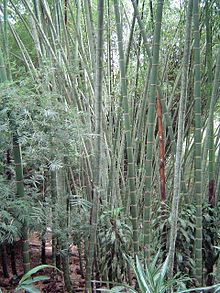Guadua
| Guadua | |
|---|---|
 |
|
| Guadua angustifolia | |
| Scientific classification | |
| Kingdom: | Plantae |
| (unranked): | Angiosperms |
| (unranked): | Monocots |
| (unranked): | Commelinids |
| Order: | Poales |
| Family: | Poaceae |
| Subfamily: | Bambusoideae |
| Supertribe: | Bambusodae |
| Tribe: | Bambuseae |
| Subtribe: | Guaduinae |
| Genus: |
Guadua Kunth |
| Type species | |
|
Guadua angustifolia Kunth |
|
| Synonyms | |
|
Bambusa Mutis ex Caldas 1809, illegitimate homonym not Schreb. 1789 |
|
Bambusa Mutis ex Caldas 1809, illegitimate homonym not Schreb. 1789
Guadua is a Neotropical genus of thorny, clumping bamboo in the grass family, ranging from moderate to very large species.
Physically, Guadua angustifolia is noted for being the largest Neotropical bamboo. The genus is similar to Bambusa and is sometimes included in that genus. Several animals are, to a various extent, associated with stands of Guadua bamboo, for example several species of seedeaters, and the Amazon and Atlantic Bamboo Rats.
The genus can be found in a wide range from northern Mexico and Trinidad to Uruguay, but most of the species are concentrated in the Amazon basin and the Orinoco basin. They usually grow at low altitudes (below 1,500 m), but has been found up to 2,500 m. Its habitats include lowland tropical and lower-montane forest, savannas, Cerrados, gallery forest, and disturbed inter-Andean valley vegetation.
From a utilitarian perspective, Guadua is the most important American bamboo. Due to its quality, the genus has been widely used for house construction along the inter-Andean rivers of Colombia and in coastal Ecuador.
Guadua angustifolia, endemic to Tropical America, is slowly becoming well known once again as a building material. Highly appreciated by Simon Bolivar for its watershed protection and praised by Alexander von Humboldt for its wide variety of uses, it is being used in construction today in South America.
...
Wikipedia
